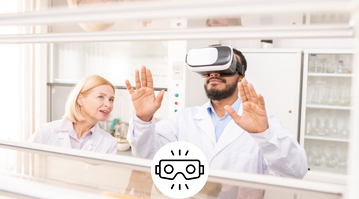Virtual Reality Guide: All You Wanted to Know
What is VR?
Virtual reality indicates an immersive shift in the way we experience the digital world. To be exact, it is a simulated experience that can either be similar or entirely different from the physical world, finding applications in business, education, and entertainment. The environment is perceived via a device known as a VR headset. Other distinct kinds of VR-based tech include AR and mixed reality, sometimes known as extended reality (XR).
VR: A Complete Knowhow
The VR life cycle bloomed when the earliest models of the Oculus Rift were displayed at the E3 video game trade show back in 2012, though the technology has been lingering in our collective consciousness for more than a centennial. As with most innovative tech, the vision came into light with 1935 science short story fiction – Pygmalion’s Spectacles by Stanley G Weinbaum, where researchers formulate a glass pair that creates an illusion of you being in the story speaking to the shadows and shadows replying, instead of being on the screen. In the late 1960s, a computer science professor from the University of Utah – Ivan Sutherland, developed Sketchpad – the forerunner of the 1st graphic computer interface. Sutherland and his colleague David Evans joined the private sector, modifying their projects to fly simulator products. NASA and The Air Force were actively researching head-mounted displays that eventually leads to huge helmets that can envelop astronauts and pilots in the 360-degree space illusion. Inside the space, they can see a digital simulation of the world outside their flight, with their instruments superimposed in a 3D display. In 2020 the world of virtual reality will be explained by stand-alone headsets. The tethered-to-a-desktop headsets are an extravagant option for hard-core fans seeking for top-notch fidelity experience, but the untethered stand-alone type offers an immersive tech that previous models can’t offer.
The Future of VR
While the immersive technology adds a whole new level to entertainment, VR goes beyond gaming – learn a new language, teleportation, or step abroad in the International Space Station. Considering the VR’s chance in the healthcare sector – Oculus has partnered with Children’s Hospital Los Angeles to develop VR simulation to educate medical students and staff about high-risk pediatric trauma, allowing them to practice and learn in a realistic workplace followed by enhancing their skills to treat patients. In the automotive sector, VR is leveraged to experiment with new automotive prototypes. VR is also used in the retail sector, offering us a virtual clothing and accessories trial, easing up our purchasing decisions.
Implementation of VR
VR Software For Medical Industry
- Super Detailed Human Anatomy Analysis to Cure Diseases from the Root
- VR Device to Reduce Pain of Traumatic Therapy (Chemotherapy Infusion)
- A Virtual Reality to Deliver High-Quality Interactive Surgical Training
- Mental Health Therapy with VR Headset
- 3D Visualisation Prior to Surgery
- VR-Mediated Rehabilitation

VR Software For Education
- Learning with Real-Time Experimentations and 3D Models of Learning Tools
- Space-study with VR is 100% Effective Learning with Virtual Astronomical Tours
- Empathetic Learning of Inhibiting Perspectives of Every Incidents and Object
- VR Model of High-Level Architectural Work for Engineering Students

VR Software For Automobile Industry
- Early Design and Obstrusion Identification of The Vehicle Through VR
- VR Saves POC Expense with Easy Demonstration of a Real-Life Experience
- VR Boost Vehicle Sales With Super Experience of Test Drive
- VR Satisfy Customer’s Expectation by Analysing The Exact Demand of Customer
- Remote Repairing and Maintenance through VR Technology



